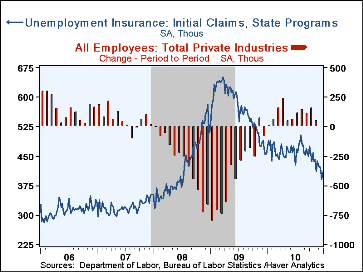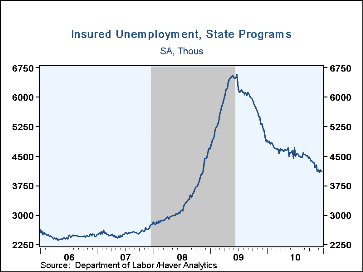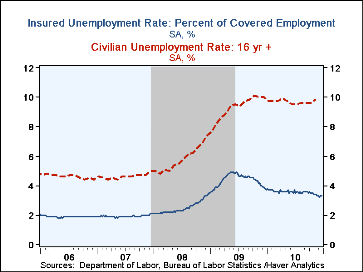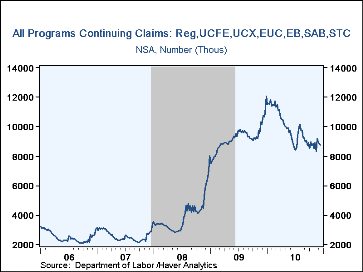 Global| Jan 06 2011
Global| Jan 06 2011U.S. Initial Jobless Insurance Claims Rise Modestly
by:Tom Moeller
|in:Economy in Brief
Summary
Initial claims for unemployment insurance rose last week to 409,000 from 391,000 (initially reported as 388,000). The latest was higher than expectations for 400,000 according to Bloomberg. Nevertheless, claims remained near the [...]
Initial claims for unemployment insurance rose last week to 409,000 from 391,000 (initially reported as 388,000). The latest was higher than expectations for 400,000 according to Bloomberg. Nevertheless, claims remained near the lowest since July 2008. The four-week moving average declined from 426,500 a week ago to 414,000, the lowest since July 26, 2008.
Coming before tomorrow's report on nonfarm payrolls, these and other data suggest strength in December jobs. 1) For the payroll employment survey week, which includes the 12th of the month, initial jobless insurance claims fell 21,000 (-4.8%) from November. 2) ADP reported yesterday a 297,000 jump in private sector payrolls. 3) Small business employment rose according to Intuit and the 4) Challenger survey indicated fewer job cuts. All of these figures are available in various Haver's databases.
Continuing claims for unemployment insurance fell 47,000 to 4.103 million and partially reversed the prior week's increase. This put the four-week average at 4.123M, the lowest since November 2008. The insured unemployment rate held steady w/w at 3.3%, versus 3.4% in November. These claimants are, however, only about half of the total number of people currently receiving unemployment insurance. Regular extended benefits, with eligibility dependent on conditions in individual states, rose 110,301 to 929,570 on that program's latest reporting date, December 18. The other extra program, Emergency Unemployment Compensation program, referred to as EUC 2008, saw a 133,625 decline to 3.578M beneficiaries in the December 18 week.
A grand total of all claimants for unemployment insurance includes extended and emergency programs and specialized programs covering recently discharged veterans, federal employees and people in state-run "workshare" programs, among others. All together, on December 18, the total number of all these program recipients was 8.766M, off 17.9% y/y. We calculated a broader insured unemployment rate by taking this grand total as a percent of the covered employment series. That rate was just over 7% on December 18. It had peaked at 9.3% on January 2, 2010.
Two other programs, disaster unemployment assistance (DUA) and trade readjustment allowance (TRA), are reported through a different Labor Department channel and have no new data this week. All of these individual program data are not seasonally adjusted.
Data on weekly unemployment insurance programs are contained in Haver's WEEKLY database, including the seasonal factor series, and they are summarized monthly in USECON. Data for individual states, including the unemployment rates that determine individual state eligibility for the extended benefits programs and specific "tiers" of the emergency program, are in REGIONW, a database of weekly data for states and various regional divisions.
| Unemployment Insurance (000s) | 1/1/11 | 12/25/10 | 12/18/10 | Y/Y % | 2010 | 2009 | 2008 |
|---|---|---|---|---|---|---|---|
| Initial Claims | 409 | 391 | 420 | -10.3 | 457 | 572 | 419 |
| Continuing Claims | -- | 4,103 | 4150 | -17.9 | 4,545 | 5,809 | 3,340 |
| Insured Unemployment Rate(%) | -- | 3.3 | 3.3 | 3.9 (12/09) |
3.6 | 4.4 | 2.5 |
| Total "All Programs" (NSA)* | -- | -- | 8.766M | -17.9% | -- | 9.170M | 3.931M |
*Excludes disaster unemployment assistance and trade readjustment allowance
Tom Moeller
AuthorMore in Author Profile »Prior to joining Haver Analytics in 2000, Mr. Moeller worked as the Economist at Chancellor Capital Management from 1985 to 1999. There, he developed comprehensive economic forecasts and interpreted economic data for equity and fixed income portfolio managers. Also at Chancellor, Mr. Moeller worked as an equity analyst and was responsible for researching and rating companies in the economically sensitive automobile and housing industries for investment in Chancellor’s equity portfolio. Prior to joining Chancellor, Mr. Moeller was an Economist at Citibank from 1979 to 1984. He also analyzed pricing behavior in the metals industry for the Council on Wage and Price Stability in Washington, D.C. In 1999, Mr. Moeller received the award for most accurate forecast from the Forecasters' Club of New York. From 1990 to 1992 he was President of the New York Association for Business Economists. Mr. Moeller earned an M.B.A. in Finance from Fordham University, where he graduated in 1987. He holds a Bachelor of Arts in Economics from George Washington University.










